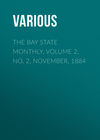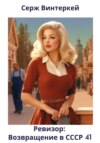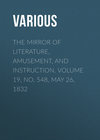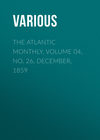Читать книгу: «The Bay State Monthly. Volume 2, No. 2, November, 1884», страница 7
The Congress House, built in the same year, was the mansion of Daniel Hammond, and stood on the north-east corner of Pearl and High streets. It was opened as a public house in 1840, and was kept by Hastings, until it was swept away in the great fire before alluded to.
The Greyhound Tavern stood on Washington street, opposite Vernon street, upon the site of Graham block. It was built in 1645, and was famous for the excellence of its punch, and was much resorted to by the convivial spirits of Boston and vicinity. Its last landlord was John Greaton. In 1752, and for many years subsequently, the Masonic fraternity celebrated St. John's day there, and the courts sat there during the prevalence of small-pox in Boston. A catamount, caught in the woods about eighty miles from Boston, was exhibited there. It was a recruiting station for enlistments during the French war. Gen. Washington resided there during the winter of 1776. It ceased to be a tavern just after the Revolution. Such was its size that it contained forty fireplaces. On its site was erected the first fire-engine house in Roxbury. A portion of the building still stands in the rear of Graham block.
The Flower de Luce Tavern was built in 1687, and stood on the north-east corner of Bartlett and Blanchard streets. It was there, in 1698, that a meeting was held "to settle about the Muddy river people worshipping In their house." Its last landlord was Samuel Ruggles.
The Punch Bowl Tavern was built in 1729 by John Ellis, and stood in Brookline, about two hundred feet west from the boundary line between Roxbury and Brookline, upon the present site of Brookline gas-works, on the south-west corner of Washington street and Brookline avenue. It was a two-story hipped-roof house, and its enlargement from time to time, by the purchase and removal of old houses thither from Boston and vicinity, resulted in an aggregation of rooms of all sorts and sizes, and produced a new order of architecture, appropriately called "conglomerate" With its out-buildings it occupied a large space, and was of a yellowish color, with a seat running along the front under an overhanging projection of the second story. In front and near each end were large elm-trees. Under the west end stood a pump, which still remains. Its sign, suspended by a high, red post, exhibited a huge bowl and ladle, overhung by a lemon-tree. It had a large dancing-hall, and was a favorite resort for gay parties from Boston and vicinity. It was patronized by British officers before the Revolution. The mill-dam and the bridges destroyed its usefulness, and it was bought by Isaac Thayer, and demolished in 1833, with the exception of one of its adjuncts, which now stands on the easterly side of Brookline avenue, nearly opposite Emerald street.
Kent's Tavern was built in 1747, and stood on the site of Grove Hall, built by, and for many years the mansion of, Thomas Kilby Jones, a famous auctioneer of Boston, and now known as the "Consumptives' Home," on the south-east corner of Washington street and Blue Hill avenue. It was originally the home-stead of Samuel Payson, and was owned by John Goddard in the early part of the last century. It ceased to be a public house in 1796.
Hazlitt's Tavern stood on the corner of Washington and Palmer streets. It was built in 1764, and had a deer's head for a sign. Afterwards it was known as the "Roebuck Tavern," John Brooks being its last landlord. It was first occupied as a public house in 1820, and it was the place of refuge of Edmund Kean when driven by a mob from the (old) Boston Theatre, December 21, 1825.
The Peacock Tavern was built in 1765, and stood at the south-westerly corner of Centre and Allandale streets, near the famous mineral springs. It was kept by Capt. Samuel Childs, who led the minutemen company of the third parish in the Lexington battle. It was purchased in 1794, with forty acres adjoining, by the patriot Samuel Adams, and he occupied it during his gubernatorial term as a summer residence, and afterward until the close of his honorable life.
On the north-west corner of Washington and Vernon streets, where Diamond block now stands, there formerly stood an old house, which was occupied in 1805 as the Old Red Tavern, kept by Martin Pierce.
The City Hotel was built of brick in 1804, and stood near the north-west corner of Washington and Zeigler streets, and was the mansion of George Zeigler. It ceased to be a public house about a third of a century ago.
Taft's Tavern stood at the north-west corner of Washington and South streets, near the Roslindale station, on the Dedham Branch railway. It was built in 1805, and first kept by Sharp & Dunster, and was long famous for good dinners. The widow of Samuel Burrill kept it during the War of 1813-1815. It is now the Roslindale Hotel.
The Norfolk House was built in 1781, and was the mansion of Joseph Ruggles, a well-known lawyer of that day. His uncle Joseph kept an inn in Roxbury in 1765. After the decease of Capt. Nathaniel Ruggles the mansion was the residence of Hon. David A. Simmons, who sold it to the Norfolk House Company in 1825, and it was opened in the following year as a public house, a large brick addition having been built containing a hall for public assemblies, known at first as Highland Hall, subsequently as Norfolk Hall, which, in 1853, was moved to the rear. The old mansion now stands on the north side of Norfolk street, and is occupied as a tenement-house. It was the starting-point of the Roxbury hourly coaches, which began running to the Old South Church on the first of March, 1826; fare, twelve and a half cents. It ceased to be a public house a generation ago, and became the pioneer of that large class of domestic and social comforts designated as "family hotels," no less than sixty of which now stand where, half a century ago, the tide ebbed and flowed.
In 1635 Robert Long with his wife and ten children arrived from Dunstable (Eng.) at Charlestown, and in 1638 purchased the so-called "Great House," originally erected by Thomas Graves for the governor's residence, for court-meetings, and public religious worship, which stood in what is now City square, opposite the Waverley House, and the base of the Town Hill. In a few years it was abandoned. Long paid £30 for the premises, to be used as a tavern, or ordinary. No use of tobacco, no card-playing, and no throwing of dice was allowed. He was allowed the use of a pasture, provided he would fence it, for the use of the horses of the guests. He was liable to a fine of ten shillings for every offence of selling at a price exceeding sixpence for a meal, or taking more than a "penny for an ale-quart of beer out of meal-times," or for selling cake or buns except for marriages, burials, or like special occasions. The tavern was well known afterwards as "The Three Cranes." Mr. Long and his sons following him carried on the house for three-quarters of a century, Robert, the first landlord, died January 9, 1664, and his widow May 27, 1687. In 1683 John, son of Robert, willed the house to his widow Mary, daughter of Increase Nowell. The estate had a brew-house attached to it. In 1711 the property was deeded by Mrs. Long to her son Samuel, and named in the deed as the "Great Tavern." Samuel, in 1712, sold it to Ebenezer Breed, when the house was called "The Old Tavern." The building was probably burnt in the destruction of Charlestown, on the day of the Battle of Bunker Hill, June 17, 1775. Finally, the land was bought by the town, and is now part of City square.
The Cape Breton Tavern was built in 1731, and stood on the corner of Main street and Hancock square. It was burnt in the general conflagration of June 17, 1775.
The Ship Tavern was built in 1748, and stood on the south-east corner of Charles River avenue and Water street. It was kept by Benjamin Gerrish.
The Warren Tavern was built in 1775, and still stands on the south-west corner of Main and Pleasant streets. It was first kept by Eliphalet Newell. It was from that edifice that the procession connected with funeral ceremonies in honor of GEORGE WASHINGTON started on the 31st of December, 1799, when the nation mourned as one man the departed patriot, statesman, and chieftain, "upon whose like they should not look again."
Trumbull's Tavern stood on the north-east corner of Charles River avenue and Water street. It was built in 1771.
The Indian Chief Tavern was built in 1779, and was the mansion of David Wood, an influential citizen of Charlestown. It occupied the site of Harvard Church. It was there that David Starrett, cashier of the Hillsboro', N.H., bank, was said to have been robbed and murdered on the evening of March 26, 1812. Suspicion attached to Samuel Gordon, the landlord. A reward of $200 was offered for the recovery of his dead body, but without success. In 1814 Hon. Nathan Appleton received a letter from Starrett, in South America, whither he had fled owing to the insolvency of the bank. It contained a hall, in the second story, known as "Massachusetts Hall." It was removed in 1818 to the north-west corner of Main and Miller streets, and its name changed to Eagle Tavern. It still stands, although it ceased to be a public house a quarter of a century since.
The Mansion House stood on the south side of City square and north-west corner of Warren avenue. It was erected in 1780 by Hon. Thomas Russell as a family mansion, and occupied by him until his decease in 1796. It was afterwards occupied by Commodore John Shaw, John Soley, Grand Master of the Grand Lodge of Freemasons of Massachusetts, and Andrew Dunlap, U.S. District Attorney, who conducted the trial of the twelve pirates of the schooner "Pindu," in 1834. It was first occupied as a hotel in 1835, and kept by Gorham Bigelow, and afterwards by James Ramsay. It was demolished in 1866 to make room for the Waverley House.
Page's Tavern stood at the corner of Main and Gardner streets, and was afterwards known as "Richards'", and more latterly, "Babcock's." It was the starting-point of the Charlestown hourly coaches, which commenced running April 1, 1828, to Brattle street; fare, twelve and a half cents. Passengers were accommodated by being called for, or left at their residences on cross streets. It ceased to be a public house about a generation ago.
Piper's Tavern stood on the south-west corner of Main and Alford streets.
Pierce's Hotel stood on the north-west corner of Charles River avenue and Water street. It was built in 1795 by Hon. Thomas Russell for a family mansion; but he died just before its completion. In one of its rooms was a remarkable clock with a blue dial and moving figures of men, which appeared when the clock struck the hours, and then disappeared. The ordaining council of the first pastor of Harvard Church convened there. It was at one time occupied by Silas Whitney, Jr., who was buried from there with Masonic honors in 1824. Potter, the celebrated ventriloquist, held his exhibitions there, to the delight of the youngsters of that day. It was last kept by James Walker, and its name changed to the Middlesex House. It was destroyed by the great fire of August 28, 1835.
Robbin's Tavern stood on the west side of City square and south-east corner of Harvard street. It was built in 1796, and stood directly in the rear of the site of the Three Cranes Tavern, before alluded to. It was demolished in 1816, and the Charlestown Town Hall erected upon its site, which, in turn, was demolished in 1868 to make room for the City Hall.
Ireland's Tavern was built in 1797, and stood on the north side of Cambridge street, near the Lowell Railroad bridge.
Yoelin's Tavern was built in 1798, and stood on the east side of City square and north-west corner of Chamber street. It was first occupied as a tavern in 1821, and was destroyed by the great fire before alluded to. The first meeting of the proprietors of Warren bridge was held there in 1828.
Copp's Tavern was built in 1799, and stood on the south side of City square, near the corner of Bow street. The building, which had ceased for some years to be occupied as a tavern, was demolished in 1866 to make room for the Waverley House.
"Sic transit gloria mundi." Thus have disappeared from time to time, with but few exceptions, the taverns, inns, and coffee-houses of the Town of Boston, while the bodily forms of those who took their ease in them have long since crumbled into dust. We will now resign to the pen of the local historian of a century hence to describe the mammoth hostelries of the City of Boston, which have arisen since the era of railways, steamships, electric telegraphs, ocean cables, telephones, electric lights, and other modern developments of science and art.
EDITOR'S TABLE
A correspondent asks in connection with an article in the May number on "Town and City Histories," in which was incidentally mentioned the government of Western towns by trustees, the following question: "Can you tell me where I can find that government treated of; also, that of towns in the Middle and Southern States?" The question is a hard one to answer. Of the town meeting, that peculiarly New England institution, much has been written; but about the local forms of government prevalent in the States between the Hudson and the Pacific Ocean very little has found its way into print. The local historians seem to take it for granted that all these things are understood everywhere, and so shed little light on the question. The pages of this magazine will be open to any one who can give the desired information.
The season of agricultural fairs, "cattle-shows" and the like, is about over. There is scarcely a county in New England, scarcely a State in the Union, but has had a fair of some sort or other. Most of them report better exhibits and larger attendance than ever before. Some few report a falling off in attendance. That all these fairs have done exhibitors much good is doubtful; that they have benefited the thinking portion of their attendants is unquestionable. Unfortunately, the thinking portion of a farming community is lamentably small. Most people go to a "cattle-show" to be amused; a few go to learn. The few that derive benefit from seeing the wonders of the earth collected in pens and on tables are helped just as a teacher gets benefit from a teacher's institute—both get food for thought. At the cattle-show the farmer may learn of new methods and see their results. The trouble is that the ordinary farmer goes to the fair for the same reason that the average citizen buys a ticket to the menagerie—to see the circus. There are more clowns at a cattle-show than the sawdust ever saw. The horses may not be so pretty or gaudy, but they go faster. One man defended himself very frankly at the dinner of a county fair in this State when he said: "The Lord made horses to go, and I like to see them do it." This question of trotting or no trotting at the fair is not a new one; but with age it seems to acquire toughness,—like chickens, for instance.
But passing by the horse question, we come to the question of clowns, which is really a very serious one. It may be irreverent to compare "cattle-show" orators to circus clowns, but really the temptation is irresistible; and then they are the only features of the respective exhibitions that have speaking parts. Joking aside, there are important lessons which the speaking and the speakers at the recent fairs may teach us. We find that the candidate for office has become a great attraction, one which the fair-managers bid high for. They draw well, too.
This calls to mind this year's Salisbury Beach Festival, a time-honored institution which has degenerated into a money-making affair in these later days. This year there was, to be sure, a large crowd present, but yet the attendance was smaller than in any year for a long time. The number of people present was between 3,500 and 5,000. Prominent gentlemen in Essex County were advertised to address the crowd. The newspaper comment on the event is short and to the point: "There was no speaking, as the crowd was more interested in seeing the Lawrence Base Ball Club beat the Newbury porters, by a score of 9 to 7." Again: "The principal attractions were Professors Parker and Martin at the skating rink, and the 4,000-pound ox."
O Tempora! O Mores!
Покупайте книги и получайте бонусы в Литрес, Читай-городе и Буквоеде.
Участвовать в бонусной программе




















